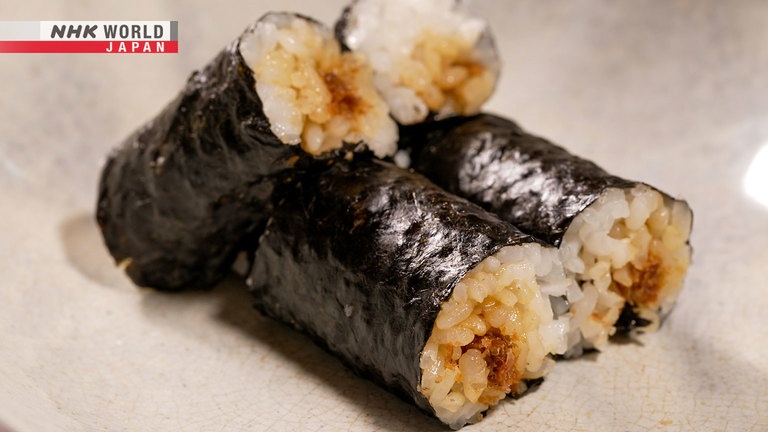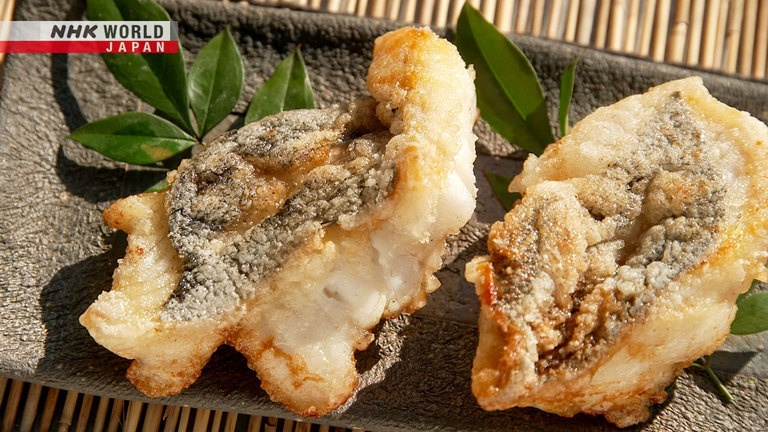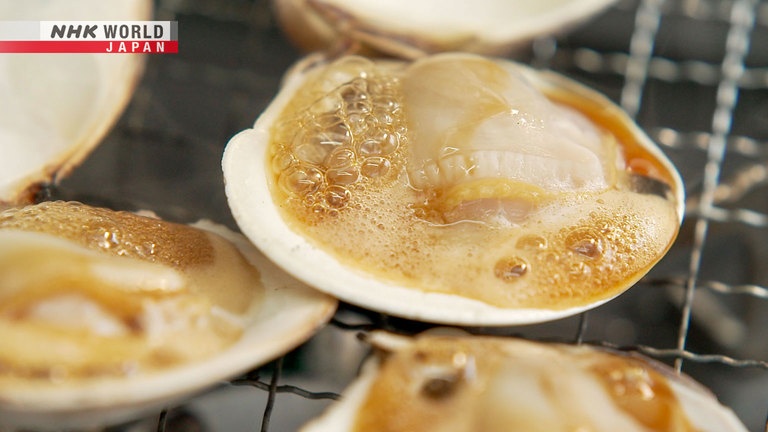Cook Around Japan - Chiba: Seafood in Tokyo Bay's Old Town
Urayasu, outside Tokyo, is now an urban leisure town, but for decades it was a fishing village. Yu Hayami discovers the unique food culture of Chiba Prefecture.
(1) "Urayasu-maki" Urayasu-style nori rolled rice

Ingredients
A half of nori, approx. 20 cm square
Rice, freshly cooked approx. 80 g
Katsuobushi (Dried skipjack tuna flakes)
Soy sauce
Directions
1. Cut the square nori in half.
2. Place the nori on a makisu (sushi mat). Spread the cooked rice on top of the nori.
3. Mix the katsuobushi with soy sauce and place along the center of the rice.
4. Bring the mat over to form a roll, and press into a shape.
5. Cut into bite-size pieces.
(2) Suzuki with Butter and Soy Sauce

Ingredients
Suzuki (Sea bass) fillets
Salt and pepper
Potato starch
Olive oil
Butter
Soy sauce
Directions
1. Season the fillets with salt and pepper and dust them with potato starch.
2. Heat the oil in a pan over medium heat and fry the fillets.
3. When the fish gets crisp outside, add butter and soy sauce. Be careful not to burn. Done.
(3) "Hamayaki" Seaside BBQ

Ingredients
Honbinosu (hard-shell clams)
Soy sauce
Scallion
Directions
1. Grill hard-shell clams over an open fire.
2. Throw away the first juice that comes out.
3. Once the clams have opened up, drizzle with soy sauce and cook for a while.
4. Top with scallions and enjoy.
(4) Gratin

Ingredients
Honbinosu (hard-shell clams)
Japanese mayonnaise
Panko
Shredded cheese
Directions
1. Grill the clams until they have opened up.
2. Cover the clams with mayonnaise.
3. Put panko and shredded cheese on top. Cook the cheese with a kitchen torch.
Transcript
Dining with the Chef.
Hello. Welcome to Cook Around Japan.
I'm your host Yu Hayami.
Surrounded by these beautiful palm trees, I feel like I'm in a resort area.
This week I am visiting Urayasu, a city in Chiba Prefecture, right next to Tokyo.
This is Narita Airport, and this is Central Tokyo.
I am right here in Urayasu City.
As you can see, much of this area was once under the sea.
Which means this city is built on reclaimed land.
And in this area, which is the downtown area of Urayasu,
you'll find restaurants that serve locally caught fresh seafood.
Urayasu fostered the development of Edomae cuisine.
Let's check out what that is.
Let's explore Japanese cuisine in greater depth.
Japan is a chain of islands approximately 3,000 km long from North to South.
There is a large variation in climate, and the terrain of each region has given rise to a diverse culture of food.
Today we're heading east of Tokyo, to Chiba Prefecture, which is mostly surrounded by the sea.
It's home to Narita International Airport, the gateway to Japan
and the Tokyo metropolis, making it a place where many people come and go.
But the traffic isn't limited to people.
From the days when Tokyo was known as Edo, Chiba has flourished as a major producer of food,
supplying the city of Edo with a wide range of ingredients.
Soy sauce is essential to Edomae cuisine.
The dark, umami-rich sauce brewed in Chiba captivated the people of Edo.
Even today, dark soy sauce characterizes the rich flavor of Edomae cuisine.
Chiba has long been a major producer of rice - which is used to make sake.
It's no wonder that Chiba is home to numerous sake breweries that provided the people of Edo with this beloved drink.
Urayasu, on the coast of Tokyo or Edo Bay, flourished as a fishing community
with its bountiful catch and cultivation of "nori" or seaweed, "asari" short-necked clams, and "hamaguri" - hard clams.
Urayasu seafood was taken to the capital, where it became a mainstay of Edomae cuisine.
The food culture of Chiba has been passed down through generations,
though in Urayasu fishing practices have changed through the years.
- Amazing.
- Perfect!
Good Job!
Yeah!
Cook Around Japan Chiba: Seafood in Tokyo Bay's Old Town.
Urayasu was once an old fishing community that stood on the banks of the rivers like this one.
Inns rented out boats for guests who came for the fishing.
Over a thousand boats were once in operation.
This is an old fishermen's cottage.
Houses on the bank always had these dirt floors which faced the river,
which made it easy for the fishermen to move their fishing gear to the moored boats.
The cottages on the opposite bank are built with a mirrored layout.
The dirt floor was used to store fishing gear and to repair and weakness
that were used to catch fish and harvest "nori" seaweed.
One-man wooden boats like this were used for harvesting, "nori."
If you look closely, you can tell that they were built to a perfect size
so that they can maneuver between the fences that cultivate the seaweed.
It's hard to imagine, but the area around the city where we began our tour was once a vast "nori" farm.
"Nori" has always been part of the Japanese diet.
This black "nori," is a traditional Japanese ingredient made by harvesting, processing, and drying edible seaweed.
Urayasu used to be one of the largest producers of seaweed in Japan.
"Nori" is an essential ingredient in foods like "onigiri," sushi and ramen.
That's why there are so many different flavors and textures.
Hello, come in.
- Thank you.
- Nice to meet you.
So, this is "nori" seaweed shop and there are so many different types of seaweed.
I don't think I've ever seen so many times before.
Yes, we sell several grades of "nori."
That's a lot!
Indeed, "nori" is classified into various grades depending on quality.
This is the premium grade, "Toku-ittokyu," made from top quality "nori."
And this bluish type is "Ao-maze" - "nori" mixed with bright green "aonori" flakes.
Can you tell the difference between the two?
The darker the "nori," the higher the grade.
The quality is also determined by the luster, the purity, and the smoothness of the texture.
It contains some "aonori," which turns
white when toasted.
It tastes totally different.
I can't tell the difference.
You will if you taste it.
I can't tell the difference but okay, I can tell that this one is the darkest actually.
First, let's try the jet-black, premium grade.
- It's thin, flaky, and very fragrant.
- It's true.
It melts in your mouth and the aroma of the seaweed just permeates in your mouth.
Chiba "nori" is the most fragrant.
This one's a little sweet.
Yes, it's bit sweet.
Compare it now to the "Ao-maze," which is a mixture of "nori" and "aonori."
- It's different.
- See?
I can tell the difference.
This "nori" is popular with kids.
It's delicious.
It's used in "onigiri" and sushi rolls.
It makes for a great snack, too.
Very fragrant.
"Nori" was cultivated in Urayasu for a long time.
So people love their "nori."
They eat it at every meal.
With soy sauce?
Yes, we can't live without "nori."
In Japan, "nori" is cultivated from Tohoku, in the north, to Kyushu in the south.
The Ariake Sea in Kyushu is one of the major producers of premium grade "nori,"
but the "nori" from Chiba these days is rare, known for its aroma and flavor.
It became popular in the Edo period and remains one of the top brands from Tokyo Bay.
People used to dry "nori" in the
nearby paddy fields.
They farmed and fished.
They'd dry one side until it crackled,
and then dry the other side.
We could hear the "nori" crackling.
They have a very rare "nori" which is untoasted and simply dried.
See how lustrous it is?
Some people still prefer untoasted "nori."
- So they toast it at home.
- Yes, it's more fragrant that way.
Shall we try toasting it?
- Really?
- I'll show you how.
In a toaster oven, toast briefly, checking often until it's crispy.
The color will change.
It's seaweed so it turns green.
The aroma changed too.
Can you tell the difference?
Yes, it's stronger.
It's very fragrant.
Ariake "nori"(from the Kyushu region)
is thick and firm.
Chiba "nori" is softer, so it's
perfect for sushi rolls.
That's probably why most Edomae sushi
used Chiba "nori."
I see.
We asked Tanaka to make a "nori" rice roll, that's a local favorite. It's called an "Urayasu-maki."
Place the "nori" on top of the "makisu" mat.
And spread on a thin, even layer of rice.
Season with "katsuobushi" with soy sauce and spread along the center of the rice.
Bring the mat over to form a roll, and press into a shape.
Cut into bite-size pieces and dig in.
Smells so nice.
Hmm, that's so good.
Delicious!
Good, isn't it? You can really
taste the "nori."
Lots of lots of umami flavor.
It's full of umami, and it's sweet.
I wonder why?
- Probably the "nori."
- You think so?
They make for a quick and delicious
breakfast.
Kids eat the rolls, miso soup, and
rolled omelet, and rush off to school.
Nice!
Perfect meal in the morning.
The waters off Urayasu are still teeming with fish.
Let's look at today's catch.
A "suzuki," or sea bass.
Since the Edo period, sea bass caught in Edo or Tokyo Bay, were considered a premium white fish, equal to sea bream.
This shop is run by the captain.
Freshly caught fish are auctioned off at Toyosu and other markets around the country.
It also sells fish directly to consumers.
Hello, come in.
Wow, look at this beautiful fish.
- You caught it this morning?
- Yes.
Can you tell me what kind of fish it is?
- It's a ‘Suzuki (sea bass).'
- Woo. Sea bass.
Wow.
It was caught in Tokyo Bay,
so it's called an ‘Edo-mae' fish.
We fish in the rich waters
off the coast of Haneda, Tokyo.
Nice looking shellfish.
They're ‘Honbinosu' (hard-shell clams),
native to North and Central America.
But they're shortnecked clams.
In the West, they're used to make
clam chowder.
- May I pick one up?
- Sure.
This is huge.
It's so heavy.
And look how thick it is.
- It's a beauty.
- It produces a delicious broth.
Sashimi is the best way to enjoy
sea bass.
It looks delicious!
These waters are rich in plankton,
which is what the fish feed on.
So, they're much fatter
than the ones in the high sea.
They can be found all over Japan, but
nearly 80% are landed in Tokyo Bay.
During the Edo period, when there was no ice production, sashimi was a rare treat.
So the delicate taste of freshly caught sea bass was very popular with the people of Edo,
who prided themselves on having a discerning palate.
This is as fresh as it will get.
You can tell this is little more softer.
Ah, It's sweet!
It's so sweet.
Oh, and the texture is delicious, very fresh.
Oh, and it's really good.
As you bite into it as you chew it more, it's sweet.
Oh, that's delicious.
It's sort of like peanut butter but not really but it has that stickiness to it which is a sign of fresh fish.
He's now going to saute the sea bass in butter and soy sauce, fisherman style.
He said this is "ryoshimeshi," which means like, you know, this is just a regular fisherman's simple way of cooking.
He seasons the fillets with salt and pepper and dusts them with potato starch.
Then, he places them in the pan skin side down, to crisp the skin.
The skin is going to come out very crispy and delicious.
Once the skin is crisp, turn over
and cook until they're light and fluffy.
Looks delicious. Nice and crisp.
And to finish, some butter for added aroma and flavor.
One drop of soy sauce.
Nothing like butter and soy sauce.
So good.
Hmm! It's very simply cooked with salt and pepper and with butter.
But you can tell because it's so fresh, the ingredient is so fresh.
It's delicious.
Can you hear it?
Next, a great way to eat hard-shell clams.
The best way is to grill them over an open fire.
It's called "hamayaki."
These are definitely going to taste great.
Look at that juice! Yum!
- Throw this away.
- What!?
Because it's mostly sea water.
Ah, because the clams take in water.
It's best to throw away the first juice that comes out, so that you get a more concentrated umami flavor.
Once the clams have opened up, drizzle them with soy sauce, and that's it.
And finally, some chopped scallions.
That looks so good!
It's hot!
Oh that's so good.
And now for a simple gratin, that the captain swears by.
Cover the grilled clams with mayonnaise...
"Panko"...
And shredded cheese.
And finally, use a kitchen torch to brown the cheese and "panko."
Now you have a delicious, clam au gratin.
It's so creamy and it's so juicy too.
- Clam au gratin!
- Just like a regular gratin.
Wow this is delicious.
A good contrast from what I had in the beginning, which was very fresh and savory, this is creamy and sweet.
But it's very good.
Delicious. Bravo!
Finally, an Urayasu speciality.
Hello.
Hello, come in.
Wow. This is so nice.
Oh, what is that?
That's amazing. May I take a look at that?
Yes, let's take a closer look.
- These are "asari," and these are "hamaguri."
- Clams, "hamaguri," large clams.
Shelled clams are threaded on skewers, grilled and dipped in sweetened soy sauce.
It's the ultimate comfort food in Urayasu.
Urayasu used to be called a "shellfish town" because of the abundance of clams
that were harvested and shipped to markets in Tokyo.
Shellfish farming was one of Urayasu's key industries.
One day, a savvy merchant, came up with the idea of making grilled clam skewers,
which the locals quickly embraced as their favorite comfort food.
Is there big difference in taste?
No. They're practically the same.
May I ask How much is it for one skewer?
- The "asari" ones are 60 yen.
- 60 yen!?
That's it!?
These are 180 yen.
Hello.
I want one!
Do you like clams? Yes?
Is it delicious? Really?
Thank you.
Is it good?
Have a bite. Oh, you can eat that?
Is it good? Yummy?
We always drop by on our way home.
You love it, don't you?
So cute!
Come along now. Thank you.
Thanks for coming!
So, kids drop by on their
way home from school. Amazing.
Yes, kids love them.
Wow! They make for a great healthy snack!
So, what do they taste like?
So I'm going to try it. It smells really good.
It has that, you know, sweet and savory smell of soy sauce and sugar.
First, the grilled "asari."
Teriyaki sauce. Hmm.
Oh, that's so good.
Now, let's try the grilled "hamaguri."
And that's very good, too.
Oh, I guess the texture is different, but overall, because they used the same source, it's very similar.
But I feel like maybe because this has a bigger surface area, it tastes a little more elegant.
Let's take a peek at the processing area.
- You do all this manually?
- Yes, by hand.
The parboiled clams are threaded onto skewers by hand. It's all hands on deck.
And how many do you skewer a day?
Two thousand...
Two thousand? Wow, that's amazing.
Per person? Oh, in total.
Everyone is a pro.
But they have to work all day long to thread enough skewers.
The skewers are then set aside overnight and grilled first thing in the morning.
The grilling is done by two people.
They've worked together every day for nearly 40 years.
During peak season, they grill 2,000 skewers in one day.
The key to making the clams moist and tender is to grill them over charcoal.
They're charcoal grilled, so we
have to keep a close eye on them.
Once the skewers are cooked through, they are dipped in a special sauce
made with soy sauce, sugar, and some other special ingredients, and they're ready to eat.
Not sure if I can do this.
Okay, they're going to let me try to skewer.
Now Yu is going to give it a try.
The trick to threading the clams is to push the skewer through the fattest part and out through the upper water tubes.
Thread four clams on each skewer, leaving a tiny bit of space in between.
Too much space and the skewer will burn when grilled over charcoal.
But if they're packed too tightly together, it doesn't look very nice.
If you don't pierce the stomach,
it won't stay in place.
- Here?
- Yes, that's the stomach.
This is hard.
- Like this?
- Push.
- Amazing.
- Perfect!
- How about this?
- Good job!
Yeah!
They're good for bentos.
I bet they're delicious.
I hope you enjoyed this week's episode featuring Urayasu.
This area which was once a fishing community has developed and flourished into a modern city,
all the while fostering the development of Edo food culture.
It was wonderful to meet the local people who take great pride in their food culture and how that is passed on to generations.
Urayasu city is right next to Tokyo, so if you ever get the chance to visit Tokyo,
make sure to make a stop here because it is wonderful.
Thank you so much for watching.
Until next time, see you!